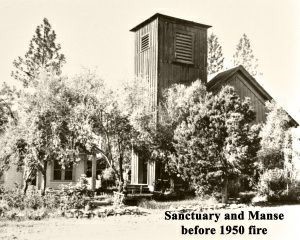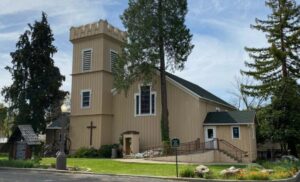A Brief History of Church of the 49ers

During the mid-1800s the discovery of gold in California attracted pioneer-spirited men and women to this area with the lure of quick and easy wealth. The “raucous 49ers” extracted the glittering color from Columbia’s immense deposits. Founded in March 1850, Columbia boasted a population as high as 6,000 by the mid-1850s. Much of the town’s infrastructure was hastily built and rebuilt due to the ravages of fire, so civic order was not a priority. However coarse these early fortune hunters were, most had been raised according Christian principles and ideals, so as women and children joined them in Columbia, some community-minded citizens developed schools and at least five churches in the area. The Dobbins’ Pulpit honors the pioneer preachers who came from many distant states in the early 1850s to serve the Mother Lode churches.

Thus, First Presbyterian Church of Columbia was established December 19, 1854. The Rev. John Brodt was the first Pastor. Many early parishioners were local miners, which earned the church the nickname “Church of the 49ers” — the name most commonly used today. In March 1855 the members purchased a rickety board and batten structure that had been hastily erected by the Methodist Episcopalians on this site. That first building was used until it was razed to erect a new sanctuary building in 1864 at a cost of $3,000. The wood structure was a modest 52 feet by 38 feet with a 43-foot belfry.

By the late 1800s the glory days of Columbia were fading, and the population eventually dwindled to about 500. During the 1930s membership in this church decreased as well to a low of two. At that time, the church was usually without a resident pastor and the congregation became a “mission” church operated by the Presbyterian National Board of Missions with services performed by seminary students.

One of this church’s most unusal pastors, Rev. Hugh Fumeaux (1914- 1926), preached the Good News to miners, ranchers and loggers in remote camps with his two sonorous companions, Bag Pipe and Pipe Organ (donkeys).
Many early parishioners of the First Presbyterian Church of Columbia were local miners, which earned it the nickname “Church of the 49ers” – the name the church is most commonly known as today.
When the State of California purchased downtown Columbia in 1945 to turn it into a State Historic Park as a living monument to the past, the town and the area again began to grow as the economy improved. In the spring of 1950, the deteriorating church building was restored and rededicated. The Prebyterians had worshipped in the historic sanctuary for 86 years, and it was recognized as the oldest Presbyterian Church building in continuous use in the Sierras. Unfortunately, seven weeks later in June 1950, a fire destroyed the Sanctuary and the nearby minister’s house (Manse).
Since there was no insurance, Pastor Joseph Hillhouse led the members in raising funds and planning for a new sanctuary. A rebuilding campaign was undertaken by offering square-headed nails recovered from the Sanctuary ashes in return for contributions and by starting a massive letter campaign. Ramont Hall was erected soon after the fire to the west of the church site and was used as a sanctuary / social hall / pastor’s quarters / church office, until our present campus was built.

The current Sanctuary was rebuilt to closely resemble the historic 1864 building, though larger, and was rededicated on 12/19/1954 on the 100th anniversary of the founding of the This unique landmark with its bell tower and stained-glass windows presents a beautiful setting for Worship which includes Scripture, prayer, liturgy, communion, and music that is a mixture of traditional & contemporary songs accompanied by a variety of musical instruments. Rev. Geroge Crichton (1958-1968) spearheaded installation of the stained glass windows (1960s).

With a grand piano and organ, the Sanctuary also draws the public for special occasions such as concerts and weddings. With a maximum occupancy of 229, it seats 165 people comfortably (floor and balcony with additional space in the choir lofts) and includes a large room and several small rooms and restrooms downstairs. In 2005 an ADA access ramp and main floor ADA restroom were added. From 2017-2020 improvements included installing a modern audio/visual system, replacing pew cushions and carpet, and adding 3 spotlights. In the past ten years, exterior stairs and gutters were replaced, and 3 sides of the Sanctuary and Bell Tower were reclad with Hardi Plank. Only the front wall of the Sanctuary needs recladding.

A separate Office Building, built around 1960 to the east of the Sanctuary, provides the Pastor’s Study, Church Office, and second office with a meeting/choir room below. In 2017 extensive repairs were made to the foundation, and new stairs up to the porch were constructed in 2024.

Increased attendance of the 1970s-80s led to the addition of the 2-story Christion Education building in 1981-82 for Preschool and Sunday School It was recently repainted and re-roofed, and five classrooms and an ADA restroom were remodeled in 2020-23. Nancy’s Hope Food Pantry is located on the lower level, off the church-owned parking lot. The parking lot directly across from the Sanctuary is owned by Columbia State Historic Park and is also available for our use.

In the late 1990s the Ramont Hall (west of the Sanctuary) was torn down in order to build Faith Hall, which was dedicated on 3/25/2001. It is used for church functions and community events. It includes a commercial kitchen, a meeting room (named the Ramont Room), restrooms, storage rooms upstairs, and a workshop basement. Recently, the exterior was repainted, the roof received elastomeric coating, and in 2024 we completed the installation of solar panels to reduce our PG&E bills. Our facilities are maintained by a gardener and custodian under the supervision of our Buildings and Grounds Elder, and a live-in Covenant Partner provides oversight of the campus.
Nestled within the captivating landscapes of California’s gold rush heartland, our beloved Church of the 49ers finds its home in the picturesque county of Tuolumne, a treasure trove steeped in history and natural splendor. The allure of this unique setting is not just in its scenic wonders and wildlife but also in the promise of a simpler, more fulfilling way of life. Here, in Columbia where the echoes of the Gold Rush era still resonate, our church stands as a thriving testament to God’s provision and grace. We remain the only full-time church in Columbia.
Our church, deeply entwined in the fabric of Columbia’s past, extends its warm embrace to the region, embodying our commitment to outreach and community engagement. We are not just a place of worship but a beacon of unity and service, enriching the lives of our neighbors. Our community values its rich history, hard work ethic, and spirit of generosity. These values resonate within our church, fostering a strong sense of belonging and support among our members.
Amidst the local natural grandeur and cultural richness, our church stands as a refuge of tradition, history, and service. Step into our world, where history comes alive, nature’s beauty enchants, and community thrives. Discover the essence of Columbia and the warmth of our Church of the 49ers, where every soul finds solace and belonging.
